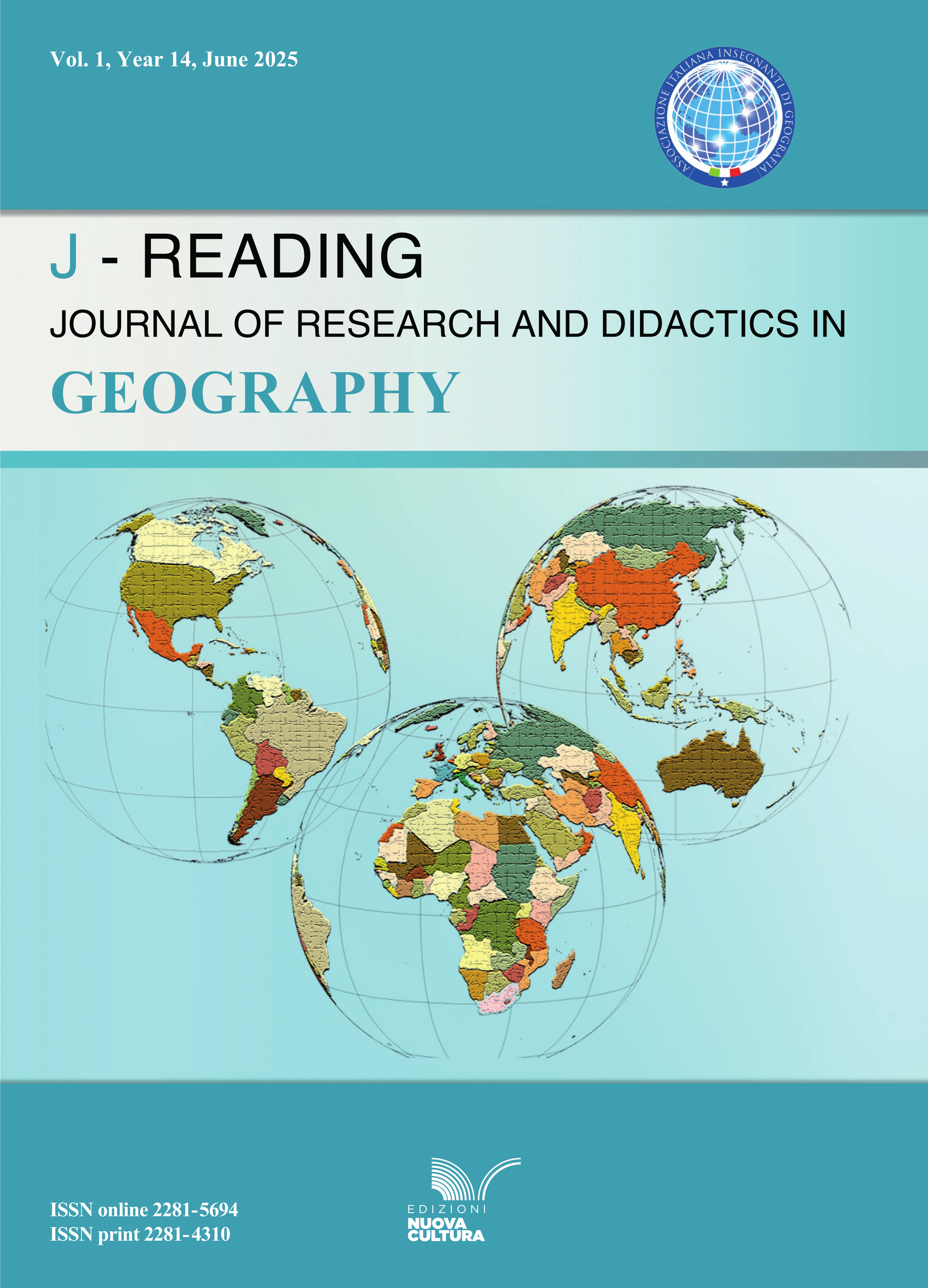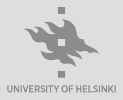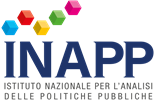Teaching and learning Geography in Italian First Cycle of Education: knowledge elements and proposals for a renewed curriculum
Abstract
Nowadays Italy is experiencing a lack of policy in defence of the teaching of Geography, and this has caused the marginalization of this disciplinary field over time, especially in the secondary school. The primary and the lower secondary school (First Cycle of Education) represent a positive exception. However, for these school grades it has long been evident that solutions need to be proposed and implemented with regards to complex issues, i.e. the contents to be taught, the potential and role of geographical education in a multidisciplinary perspective (e.g. Civic Education), and finally teacher training. Above all, an updating of the curriculum proposals seems necessary, especially in the light of the environmental challenges and sensitive social issues of the contemporary world. Starting from the existing conceptual framework and the results of a survey provided to a sample of teachers, this paper offers some knowledge elements and proposals about the actions to be taken to contributing to renew the Geography curriculum in the Italian First Cycle of Education.References
Augé M., Non-lieux. Introduction à une anthropologie de la surmodernité, Paris, Ed. du Seuil, 1992.
Barthes A., “The Hidden curriculum of sustainable development: the case of curriculum analysis in France”, Journal of Sustainability Education, 18, 2018, ffhal-01788266.
Barthes A. and Alpe Y., “Les ‘éducations à’, une remise en cause de la forme scolaire”, Carrefours de l’éducation, 45, 2018, pp. 13-21.
Beitone A., “Enseigner des questions socialement vives. Note sur quelques confusions”, 7ème biennale de l’éducation et de la formation, Lyon, 15 avril 2004, pp. 1-12, https://lms.fun-mooc.fr/asset-v1:uved+34008+session01+type@asset+block/QSV-Confusions_A.Beitone_2004.pdf
Beitone A. and Hemdane E., “École, savoirs et valeurs: une tentative d’éclaircissement”, Éducation et socialisation, 48, 2018, https://journals.openedition.org/edso /3015.
Betti S., Borghi D., Virgini L., “Sandbox Augmentation Reality (AR): geotecnologie per una didattica della Geografia tra inclusione e integrazione”, in Lazzeroni M., Morazzoni M. and Zamperlin P. (Eds.), Geografia e tecnologia: transizioni, trasformazioni, rappresentazioni, Memorie geografiche, 22, 2023, pp. 651-659.
Charpentier P., “Des savoirs émancipateurs dans une école émancipatrice? Quelques réflexions philosophiques et pédagogiques”, in Buttier J.-Ch. and Panagiotounakos A. (Eds.), Des savoirs pour agir sur le monde. Quels apprentissages des élèves face aux enjeux contemporains?, Fontaine, Presses Universitaires de Grenoble, 2023, pp. 203-218.
Charpentier P. and Fatichenti F., “Pour une éducation géographique à l’Anthropocène à l’école primaire en France et en Italie: situation actuelle, critique et perspectives”, L’information géographique, 87, 1, 2023, pp. 93-113.
Chauvigné C. and Fabre M., “Questions socialement vives: quelles approches possibles en milieu scolaire?”, Carrefours de l’éducation, 52, 2021, pp. 15-31.
Corbetta P., La ricerca sociale: metodologia e tecniche, 4 voll., Bologna, Il Mulino, 2015.
Creswell J.W. and Creswell J.D., Research Design: Qualitative, Quantitative, and Mixed Methods Approaches, 5th ed., Los Angeles, Sage Publications, 2018.
De Vecchis G., Insegnare Geografia: teoria, metodi e pratiche, Turin, UTET, 2016.
De Vecchis G. and Pasquinelli d’Allegra D., Sapere e saper fare Geografia. Teorie e pratiche nella Scuola dell’Infanzia e Primaria, Turin, UTET, 2024.
De Vecchis G., Pasquinelli d’Allegra D. and Pesaresi C., “Geography in Italian schools (An example of a cross-curricular project using geospatial technologies for a practical contribution to educators)”, Review of International Geographical Education Online, 1, 1, 2011, pp. 4-25.
De Vecchis G., Pasquinelli d’Allegra D. and Pesaresi C., Didattica della Geografia, Turin, UTET, 2020.
Fatichenti F., “Una Geografia per la sostenibilità. Il quadro epistemologico disciplinare, le Indicazioni nazionali, la prassi didattica nella Scuola primaria”, Annali online della Didattica e della Formazione Docente, 15, 25, 2023, pp. 126-140.
Frémont A., Vi piace la Geografia?, Rome, Carocci, 2008.
Gavinelli D. and Rossi B. (Eds.), Scienze sociali, Geografia e Storia nella didattica di un mondo interculturale, Milan, Cuem, 2008.
Giorda C. (Ed.), Geografia e Antropocene. Uomo, ambiente, educazione, Rome, Carocci, 2019.
Giorda C., “Lo studio dell’Antropocene: una svolta anche per la Geografia?”, Ambiente Società Territorio, 61, 3, 2016, pp. 3-8.
Giorda C., Il mio spazio nel mondo: Geografia per la scuola dell’infanzia e primaria, Rome, Carocci, 2014.
Giorda C., “Così vicine, così lontane: Storia e Geografia di fronte a un percorso comune nei curricoli scolastici”, Ambiente Società Territorio, 57, 2, 2012, pp. 12-18.
Giorda C. and Puttilli M. (Eds.), Educare il territorio, educare al territorio. Geografia per la formazione, Rome, Carocci, 2011.
Goodman L.A., “Snowball Sampling”, Annals of Mathematical Statistics, 32, 1961, 1, pp. 148-170.
Guaran A., Educazione pre-geografica nella scuola dell’infanzia: significati, valori e opportunità, Bologna, Pàtron, 2021.
Jeziorski A. and Legardez L., “Éducation au développement durable: la difficulté de concevoir une action éducative interdisciplinaire”, Revue Francophone du Développement Durable, 1, 2013, pp. 59-74.
Hammond L., Healy G., Bladh G. and Tani S., “Reflecting on the powers, possibilities and constraints of geography curricula in England, Finland and Sweden”, Journal of Curriculum Studies, 2024, https://doi.org/10.1080/00220272.2024.2420366
Lange J.M., “Curriculum possible de l’Éducation au Développement Durable: entre actions de participation et investigations multiréférentielles d’enjeux”, Éducation relative à l’environnement, 11, 2014, https://journals.openedition.org/ere/691.
Lavagna E., Lucarno G. and Rigobello P.M., Geografia per insegnare. Idee e strumenti per la didattica, Bologna, Zanichelli, 2018.
Legardez A. and Simonneaux S., L’école à l’épreuve de l’actualité. Enseigner des questions vives, Paris, ESF, 2006.
Legardez A. and Simonneaux L., Développement durable et autres questions d’actualité. Questions Socialement Vives dans l’enseignement et la formation, Dijon, Educagri Editions, 2011.
Legardez A., Simonneaux J. and Simonneaux L., “Compétences et enseignement des Questions Socialement Vives”, Education et socialisation, 24, 2008, pp. 101-114.
Lucidi L. and Pesaresi C., “Metodologie didattiche attive e Story Map per un apprendimento autentico”, Bollettino dell’Associazione Italiana di Cartografia, 177, 2023, pp. 126-147.
Malatesta S., Geografia dei bambini. Luoghi, pratiche e rappresentazioni, Milan, Guerini, 2015.
Mérenne-Schoumaker B., Didactique de la Géographie. Organiser les apprentissages, Bruxelles, De Boeck, 2017.
MIUR, “Indicazioni nazionali per il curricolo della scuola dell’infanzia e del primo ciclo d’istruzione”, D.M. n. 254/2012, Gazzetta Ufficiale, n. 30, 5 febbraio 2013.
MIUR, Indicazioni nazionali e nuovi scenari, Rome, 2018, https://www.miur.gov. it/documents/20182/0/Indicazioni+nazionali+e+nuovi+scenari/.
Molinari P., “Conoscere il territorio sviluppando competenze nella scuola primaria”, in Zanolin G., Gilardi Th. And De Lucia R. (Eds.), Geo-didattiche per il futuro. La Geografia alla prova delle competenze, Milan, FrancoAngeli, 2017, pp. 43-50.
Morri R., “Quel che resta della Geografia”, L’Universo, 1, 2020, pp. 21-31.
Morri R. (Ed.), Viaggio nella scuola d’Italia. XV Rapporto della Società Geografica Italiana, Rome, Società Geografica Italiana, 2022a.
Morri R., “Geography’s preeminence: Italian Commission for the Knowledge and Study of Geography at School”, J-READING (Journal of Research and Didactics in Geography), 1, 2022b, pp. 5-9.
OECD, PISA 2018 Results (Volume VI): Are Students Ready to Thrive in an Interconnected World?, Paris, PISA, OECD Publishing, 2020.
Pasquinelli d’Allegra D., “Proposals for the development of competences in geography by applying the IGU International Charter”, J-READING (Journal of Research and Didactics in Geography), 2, 2017, pp. 17-31.
Pesaresi C., Applicazioni GIS. Principi metodologici e linee di ricerca. Eserci-tazioni ed esemplificazioni guida, Novara, UTET, 2017.
Pesaresi C. and Morri R., “J-READING reaches its tenth year of publications in the framework of geographical journals. Geographically thinking about didactics, research and interdisciplinary approaches. Introduction”, J-READING (Journal of Research and Didactics in Geography), 2, 2021, pp. 33-41.
Piastra S., “Wuhan, metropoli incognita. Riflessioni su COVID-19, la Cina e la cultura geografica italiana”, Ambiente Società Territorio, 65, 3, 2020, pp. 16-20.
Piastra S., “Quale educazione alla sostenibilità nella scuola italiana? Luci e ombre delle nuove linee guida per l’insegnamento dell’Educazione civica”, Ambiente Società Territorio, 66, 1-2, 2021, pp. 22-26.
Pioletti A.M., “Gli strumenti per leggere il mondo. La geografia dalla scuola dell’infanzia alla scuola secondaria di secondo grado”, in Pioletti A.M. (Ed.), Gli strumenti per leggere il mondo. La geografia dalla scuola dell’infanzia alla scuola secondaria di secondo grado, Milan, FrancoAngeli, 2020, pp. 7-18.
Santerini M., La scuola della cittadinanza, Rome-Bari, Laterza, 2010.
Thémines J.F., Enseigner la Géographie: un métier qui s’apprend, Paris, Hachette, 2006.
van der Schee J., “Looking for an international strategy fogeography education”, J-READING (Journal of Research and Didactics in Geography), 1, 2014, pp. 9-13.
van der Schee J., “Geografia: sostenibilità ed educazione”, in De Filpo M., De Vecchis G. and Leonardi S. (Eds.), Geografie disuguali, Rome, Carocci, 2017, pp. 52-74.
Zammuner V.L., Tecniche dell’intervista e del questionario, Bologna, Il Mulino, 1998.
Downloads
Published
Issue
Section
License
The Author assigns to the Nuova Cultura and to Italian Association of Geography Teachers all rights under copyright that can exist in and to the submitted paper. The Author warrants that the paper and images (photos, maps, graphs etc.) are original and that he/she is the Author of the submitted contribution and its parts; in the case of images taken by other publications, the Author must provide a specific authorization and must pay in advance any copyright.

This work is licensed under a Creative Commons Attribution 4.0 International License.












